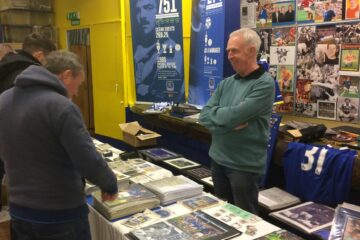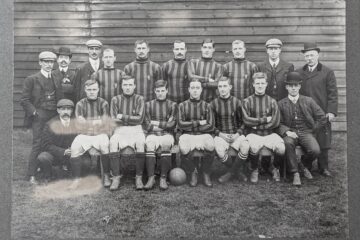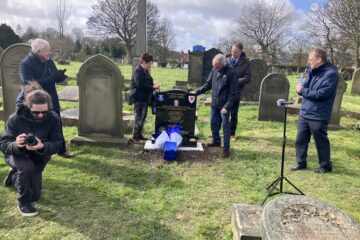
William Ralph “Dixie” Dean sits unchallenged as the king of Goodison Park. Joining him in the Royal Blue dynasty is the Prince of Centre Halves: Thomas George Jones. Tommy, as his friends knew him, was so famous in his pomp for Everton and Wales that he was known merely by his initials – T.G.
Devouring Everton history books as a youngster, I would read of this artist in the Blues’ half-back line. Dominant in the air, immaculate on the ground and possessing a rocket-like shot, T.G. was so confident in his own ability that he would dribble in his own penalty area – accompanied by gasps of fear and appreciation from the terraces. In 14 years of service at Goodison, T.G. cemented his reputation as Everton’s most cultured centre-half – overshadowing the likes of T.E. Jones, Brian Labone, John Hurst, Kevin Ratcliffe and Dave Watson.
I sometimes pondered on why T.G. walked away from Goodison to run a hotel in Pwllheli but nothing more might have come of it were it not for a chance conversation with a Bangor City supporter. Whilst helping Dafydd Islwyn with a query about Ian Hillsdon, a former Everton and Bangor left-back, he waxed lyrical about T.G.’s impact as manager of Bangor in the 1950s and 1960s. In the North Walian university city he ended a six-decade barren spell in the Welsh Cup and led the Cheshire League part-timers into three epic European Cup Winners’ Cup encounters with Italian giants Napoli.
I was hooked and, armed with Dafydd’s collection of press cuttings, I set out to document T.G.’s life and times. My research led me to Connah’s Quay – a short hop across the Dee estuary from England. His legacy in, this, his hometown, was the formation of the football club now known as Connah’s Quay Nomads. With the Welshman not having kicked a ball competitively for well over 50 years, I raced against time to collect first-hand memories of seeing T.G. play. My late father’s recollections of T.G. were corroborated by Toffeeweb contributors, such as the Harold Matthews who dubbed T.G. “Like Pirlo in a number 5 shirt.” Evertonians of a certain vintage (and contemporary match reports) were almost unanimous in their opinion that T.G. was the ultimate ball playing centre-half – some 25 years before Franz Beckenbauer announced himself on the world stage with a similar Libero playing style.
Having joined Everton from Wrexham, in his first full season as a regular starter, T.G. starred alongside Ted Sagar, Joe Mercer, Tommy Lawton, Alex Stevenson and Torry Gillick in a side which romped, unexpectedly, to the 1938/39 league title. T.G. would claim that the team was so good that it rarely had to break sweat. Hopes of further silverware were dashed by the outbreak of war. T.G.’s finest years for Everton, in the early 1940s, were never officially recognised in the record books.
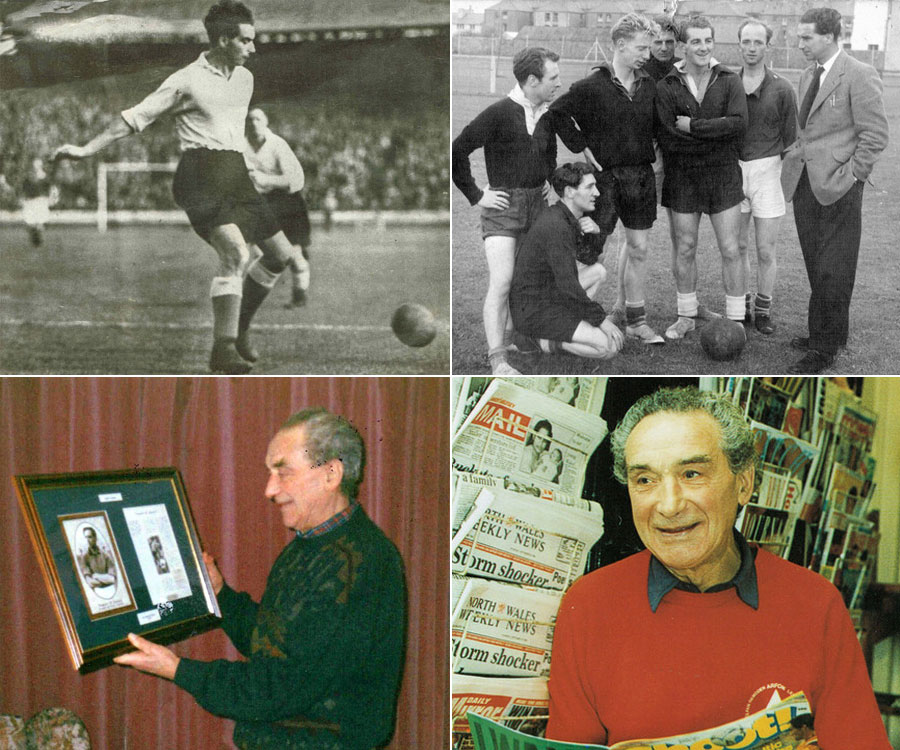
TG Jones, clockwise from top: In an Everton away shirt, post-War (courtesy of Jane Jones); Player-manager of Pwllheli FC; At home with his Everton Giant certificate; Photographed in his shop in 1990 for the Everton matchday programme
The seeds of discontent were sown in a wartime Merseyside derby when a club director tried to order a badly injured T.G. back onto the field. Disenchantment was added to resentment, post-war, when Everton sold Tommy Lawton and Joe Mercer and entered a downward spiral. In the days before agents and the Bosman ruling, T.G. fought unsuccessfully for three seasons to get a move to a more competitive club. Although still revered by the Everton faithful, he was no longer an automatic choice in the first team – often losing out to fellow Welshman, Jack Humphreys. Having fallen out with incoming manager, and former team-mate, Cliff Britton, T.G. walked away from professional football in 1950. He doubled his income as a hotelier whilst continuing to ply his footballing trade in the Welsh League North with Pwllheli F.C. Having won every competition going whilst on the Llŷn Peninsula, he switched to managing Bangor City in 1957. His cup feats there in 1962 are still marvelled at on the banks of the Menai Strait.
Having stepped away from football management after an ill-fated spell at Rhyl, T.G. wrote for the Daily Post and ran a small newspaper and sweet shop with his wife, close to Bangor Pier. Keeping a low profile, he loved walking his dogs or visiting nearby beaches on Anglesey. He would sometimes reflect ruefully on how he almost became a European football star a decade before countryman, John Charles. For, in 1948, an audacious bid to take T.G. to AS Roma collapsed at the 11th hour due to post-war currency exchange complications.

BEST BIOGRAPHY OF THE YEAR
It may come as a surprise to Evertonians but, with T.G. feeling some lingering bitterness towards the Toffees, he claimed that his happiest years in football were spent in North Wales. Visits to Goodison Park became rare – the last confirmed sighting was for Tommy Lawton’s testimonial match in 1972. In spite of his self-imposed exile from Goodison, he was selected as Everton’s Giant of the 1940s at the dawn of the new millennium.
T.G.’s immense contribution to Welsh and Merseyside football was nicely summed up by Elfed Ellis, President of the F.A. of Wales. When he presented him with a lifetime contribution award in 1993, Ellis asked the assembled guests: “What do the initials T.G. stand for?” He then answered his own question: “Too Good for defenders.”
The Prince of Centre-Halves – the Life of Tommy ‘T.G.’ Jones is published by deCoubertin Books and is available through their website, bookshops and Amazon.

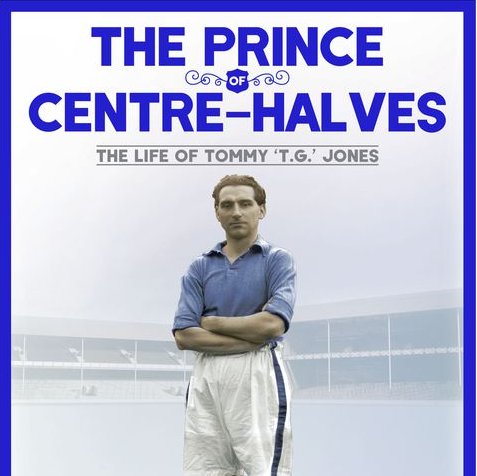
 Follow @robsawyer70
Follow @robsawyer70